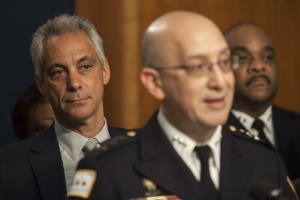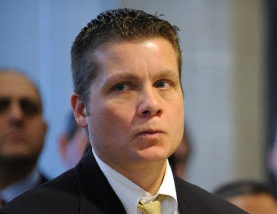The 3,085 pages of City Hall emails released Thursday by Mayor Rahm Emanuel’s administration begin with a short message dated Oct. 21, 2014, from the Chicago Public Schools:
“MACDONALD, Laquan M/17 yrs old . . . 10th grade student at YCCS-Sullivan House Alternative HS . . . shot and killed on October 20, 2014,” reads the rather unremarkable note about the teen’s death.
What would unfold over the next 14 months would be anything but unremarkable.
Eventually, Chicago police Officer Jason Van Dyke would be charged with killing McDonald, and a police video of the shooting would be viewed around the world.
As the situation evolved, Emanuel’s staff went from fact-gathering mode — and negotiating a $5 million settlement with McDonald’s family to avoid a wrongful-death lawsuit — to crisis management, monitoring everything from national news coverage of daily protests to comments that activist-priest Michael Pfleger and others said on TV and posted on Facebook, the emails show.
Over and over, mayoral aides were obsessed with how their boss was being portrayed — keeping tabs on who was seemingly in his corner — and worked to deliver a unified “message” that he was seeking justice in the case.
The records, obtained under the Illinois Freedom of Information Act, also reveal that Emanuel’s office communicated repeatedly about the McDonald case with the “independent” agency that decides whether police shootings are justified, the Chicago Sun-Times reported in its Friday editions. Aides to the mayor said those communications were routine and didn’t interfere with the Independent Police Review Authority’s investigation.
Other emails show just how quickly City Hall became aware the McDonald shooting was a heater case and the steps mayoral aides took as it intensified. Here’s a closer look at some of those developments:
After the shots
On Nov. 14, 2014, less than a month after McDonald’s death, City Hall’s law department began requesting video of the shooting from the police.
By the second week of December, city officials were fielding questions from journalists — including Chicago Sun-Times columnist Mary Mitchell — about a web posting by University of Chicago law professor Craig Futterman and journalist-activist Jamie Kalven that called on City Hall to release video footage of what had happened at the shooting scene near 41st and Pulaski. According to the Futterman-Kalven post, a witness saw the teen “shying away” from the police at the time a cop — later identified as Van Dyke — opened fire.
In a story posted on the website Slate on Feb. 10, 2015, Kalven disclosed that autopsy records showed McDonald had been shot 16 times. A link to the story was quickly shared among top mayoral aides, Emanuel’s press staff, police department general counsel Ralph Price and Stephen Patton, Emanuel’s chief City Hall lawyer.
Questions about the case intensified after City Hall reached the $5 million settlement with McDonald’s estate — a deal announced in April, shortly after Emanuel won re-election.
Reporters kept seeking the police video of the shooting. Eventually, a judge ordered the city to release it, despite City Hall’s objections.
“We lost,” city law department spokesman Bill McCaffrey emailed to his colleagues from court on Nov. 19. “Court ordered release by Nov 25.”
Damage control
With the video due out, Emanuel’s staff — particularly Kenneth Bennett, deputy chief of staff for public engagement — reached out to community leaders to attempt to prevent a firestorm.
Of particular concern was the Rev. Pfleger, pastor of the large African-American congregation at St. Sabina parish.
After Pfleger went on TV on Nov. 20 and said Van Dyke should be fired, mayoral spokesman Adam Collins emailed colleagues: “Not sure who has the best relationship, but it looks like there might be value in putting in a call to Pfleger about the process here.”
Bennett replied that he’d already spoken with him. “I can call Pfleger again but he stated to me Thursday that he would continue to call for the termination of this officer.”
The next day, Emanuel communications chief Kelley Quinn quoted a Facebook post from Pfleger in an email to Bennett and others. According to Quinn’s email, Pfleger wrote: “The officer who killed LaQuan McDonald . . . His lawyer said yesterday that the shooting was justified because the officer felt threatened. . . . How much of a threat was he after getting shot 3 times . . . that gave you permission to shoot 13 more times?????”
Later in the day, Bennett emailed, “I left Pfleger a message earlier. Waiting for his call back. He may require a call from [then-police Supt.] Garry [McCarthy] assuring him of our commitment to a transparent process. . . . I can also try to talk to him about a calmer tone in his comments and on social media.”
Assessing the fallout
Quinn kept the mayor and his staff regularly updated on news stories about Van Dyke and the video.
At 10:46 p.m. on Nov. 24 — the day charges against Van Dyke were announced and the video was released — Quinn emailed Emanuel directly, writing, “Mayor, the release of the video is the leading news item across the country on Tuesdays [sic] night. . . . With the release of the video, the coverage is highlighting the ferocity of the officer’s actions and the rawness of the footage.
“The coverage is highlighting YOUR efforts to urge calm before the video was released, but also notes how upset community members are about the developments surrounding the video. Furthermore, the coverage highlights the number of questions that protesters and commentators say still linger: Why did it take so long to press charges against the officer?; Why wasn’t the video released earlier?; Why is the police superintendent still in power?”
Emanuel fired McCarthy on Dec. 1.
As for the video’s release, the mayor had maintained he was waiting for criminal investigators to finish their work before making it public.
Aides repeatedly expressed frustration that the message didn’t always seem to be getting out.
One reporter, for example, said in a story that “Emanuel’s administration tried to keep the recording of McDonald’s death from becoming public.”
“I’d like to push back on this,” Collins wrote to Quinn on Nov. 26. It’s one of several references to the mayor’s press office doing a “push back” to media stories, columns or editorials.
Attorney general surprise . . . sort of
On Dec. 1, Illinois Attorney General Lisa Madigan sent — and publicly released — a letter to U.S. Attorney General Loretta Lynch requesting a federal inquiry into the police department.
“Trust in the Chicago Police Department is broken, especially in communities of color in the City of Chicago,” Madigan wrote. “Chicago cannot move ahead without an outside, independent investigation into its police department.”
The mayor’s office was taken by surprise. “We’re [sic] we given a heads up?” Quinn wrote a number of top mayoral aides, including Patton, mayoral adviser David Spielfogel and Melissa Green, who leads the city’s office in Washington, D.C.
“By who?” responded Green. “No.”
In fact, Madigan’s office had warned at least one Emanuel official the letter was coming. “Here it is,” Madigan chief of staff Ann Spillane emailed at 4:49 p.m. on Dec. 1.
The mayor’s office drew up a statement emphasizing Emanuel’s plan to form a commission to look at police reforms, and Spielfogel signed off on it. On Dec. 2, the mayor told reporters the idea of a federal probe was “misguided.”
The statement was met with another round of criticism. That evening Democratic presidential front-runner Hillary Clinton — who’s known Emanuel since he worked as a fund-raiser for Bill Clinton during his first presidential campaign and went with him to Washington as a White House aide— called for a federal investigation into the police department. Mayoral aides emailed each other the news.
The next day, Emanuel reversed his position, saying he “welcomed” a Justice Department inquiry.
His aides prepared for the unfavorable news coverage.
“Still going through calls with beat reporters,” Collins wrote Spielfogel. “Expect the theme to be that he backtracked.”
It was.
Four days later, on Dec. 6, Lynch announced the Justice Department would indeed open an inquiry into the police department.
“Oh my”
On Dec. 1, the Sun-Times’ Lynn Sweet reported that U.S. Rep. Luis Gutierrez, D-Illinois, was withdrawing his support for the re-election of Cook County State’s Attorney Anita Alvarez. Gutierrez said the year-plus it took for Alvarez to bring charges against Van Dyke was “inexcusable.”
Clothilde Ewing, a mayoral aide who specializes in “strategic messaging,” forwarded the story to Spielfogel.
“Oh my,” she wrote, possibly worried that Gutierrez might tee off on the mayor, too.
Emanuel was soon in touch with Gutierrez, an important Latino ally who co-chaired the mayor’s re-election campaign, to make sure they were on the same page.
In an interview on MSNBC that afternoon, the congressman praised Emanuel’s plans to assemble a police reform commission.
Soon after, a Gutierrez aide emailed a clip of the interview to mayoral staffers. “He spoke personally with MRE about message this afternoon,” the congressional aide noted.
“They spoke for about 15 minutes,” replied Emanuel aide Adolfo Hernandez. “Good call and MRE was fine after.”











































